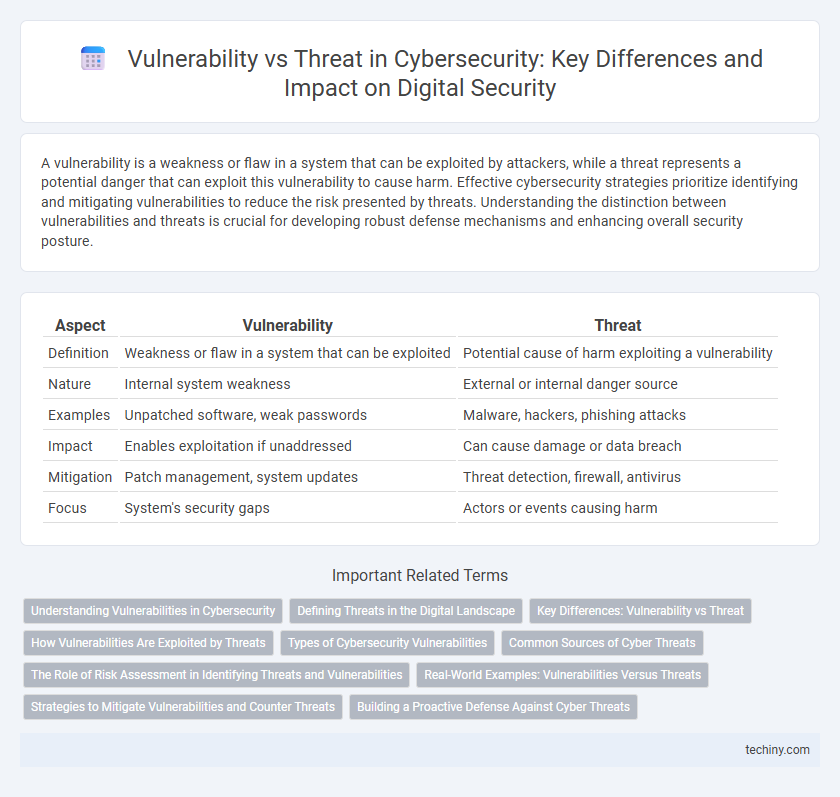A vulnerability is a weakness or flaw in a system that can be exploited by attackers, while a threat represents a potential danger that can exploit this vulnerability to cause harm. Effective cybersecurity strategies prioritize identifying and mitigating vulnerabilities to reduce the risk presented by threats. Understanding the distinction between vulnerabilities and threats is crucial for developing robust defense mechanisms and enhancing overall security posture.
Table of Comparison
| Aspect | Vulnerability | Threat |
|---|---|---|
| Definition | Weakness or flaw in a system that can be exploited | Potential cause of harm exploiting a vulnerability |
| Nature | Internal system weakness | External or internal danger source |
| Examples | Unpatched software, weak passwords | Malware, hackers, phishing attacks |
| Impact | Enables exploitation if unaddressed | Can cause damage or data breach |
| Mitigation | Patch management, system updates | Threat detection, firewall, antivirus |
| Focus | System's security gaps | Actors or events causing harm |
Understanding Vulnerabilities in Cybersecurity
Vulnerabilities in cybersecurity are weaknesses or flaws within a system, software, or network that can be exploited by cyber threats to gain unauthorized access or cause harm. Understanding vulnerabilities involves identifying and assessing these security gaps through methods like penetration testing, vulnerability scanning, and code review to reduce potential attack surfaces. Effective vulnerability management is critical for mitigating risks and strengthening overall cybersecurity posture against emerging cyber threats.
Defining Threats in the Digital Landscape
Threats in the digital landscape refer to potential dangers that exploit system vulnerabilities to cause harm or unauthorized access. These threats encompass malware, phishing attacks, ransomware, and insider breaches targeting data integrity, confidentiality, and availability. Understanding diverse threat vectors is essential for developing effective cybersecurity strategies and risk management frameworks.
Key Differences: Vulnerability vs Threat
A vulnerability is a weakness or flaw in a system, application, or network that can be exploited by attackers to gain unauthorized access or cause harm. A threat, on the other hand, is any potential danger or malicious actor capable of exploiting vulnerabilities to compromise security. Understanding the key difference between vulnerability and threat is crucial for effective risk management and cybersecurity defense strategies.
How Vulnerabilities Are Exploited by Threats
Vulnerabilities are weaknesses or flaws in software, hardware, or network systems that can be exploited by cyber threats such as malware, phishing attacks, or ransomware. Threat actors leverage these vulnerabilities to gain unauthorized access, disrupt services, or steal sensitive data, often using automated tools or social engineering techniques. Effective cybersecurity strategies prioritize patch management, vulnerability scanning, and threat intelligence to detect and mitigate potential exploitation before attackers can act.
Types of Cybersecurity Vulnerabilities
Cybersecurity vulnerabilities include software flaws, misconfigurations, and weak passwords that attackers exploit to gain unauthorized access. Common types of vulnerabilities are injection flaws, broken authentication, and insecure configurations, each creating potential entry points for cyber threats. Understanding these vulnerabilities helps organizations implement targeted security measures to reduce risk exposure.
Common Sources of Cyber Threats
Common sources of cyber threats include malware, phishing attacks, insider threats, and unsecured network devices, each exploiting existing vulnerabilities within an organization's security framework. Vulnerabilities represent weaknesses in software, hardware, or procedures that threat actors leverage to gain unauthorized access or cause damage. Understanding the distinction between vulnerabilities and threats is critical for implementing effective cybersecurity measures and mitigating potential risks.
The Role of Risk Assessment in Identifying Threats and Vulnerabilities
Risk assessment plays a critical role in cybersecurity by systematically identifying vulnerabilities within systems and evaluating potential threats that could exploit these weaknesses. It involves analyzing the likelihood and impact of various cyber risks to prioritize security measures effectively. By quantifying and mapping threats to specific vulnerabilities, organizations can allocate resources strategically to mitigate risks and enhance their overall security posture.
Real-World Examples: Vulnerabilities Versus Threats
Vulnerabilities are weaknesses like outdated software or unpatched systems that attackers can exploit, such as the 2017 Equifax breach which stemmed from an unpatched Apache Struts vulnerability. Threats refer to potential attackers or malicious activities exploiting these vulnerabilities, exemplified by the WannaCry ransomware attack that targeted vulnerabilities in Windows systems globally. Understanding the distinction between vulnerabilities and threats is crucial for effective cybersecurity defense strategies, focusing on patch management and threat intelligence.
Strategies to Mitigate Vulnerabilities and Counter Threats
Mitigating vulnerabilities requires regular software patching, robust configuration management, and continuous vulnerability assessments to identify and remediate weaknesses before exploitation. Countering threats involves deploying advanced threat detection systems, implementing multi-layered defense mechanisms like firewalls and intrusion prevention systems, and fostering employee cybersecurity awareness through ongoing training. Integrating these strategies within a comprehensive cybersecurity framework enhances resilience against attacks and reduces organizational risk exposure.
Building a Proactive Defense Against Cyber Threats
Vulnerabilities are weaknesses in systems or software that cyber attackers exploit to gain unauthorized access, while threats are potential events or actors that aim to exploit these vulnerabilities. Building a proactive defense involves continuous vulnerability assessments, real-time threat intelligence integration, and rigorous patch management to minimize attack surfaces. Implementing layered security measures and employee training further strengthens organizational resilience against evolving cyber threats.
Vulnerability vs Threat Infographic

 techiny.com
techiny.com